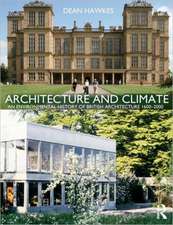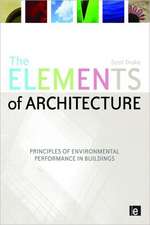The Greening of Architecture: A Critical History and Survey of Contemporary Sustainable Architecture and Urban Design
Autor Phillip James Tabb, A. Senem Devirenen Limba Engleză Paperback – 24 ian 2014
Preț: 417.68 lei
Preț vechi: 454.00 lei
-8% Nou
Puncte Express: 627
Preț estimativ în valută:
79.95€ • 86.87$ • 67.20£
79.95€ • 86.87$ • 67.20£
Carte tipărită la comandă
Livrare economică 21 aprilie-05 mai
Preluare comenzi: 021 569.72.76
Specificații
ISBN-13: 9781409447399
ISBN-10: 1409447391
Pagini: 216
Ilustrații: Includes 215 b&w illustrations
Dimensiuni: 189 x 246 x 12 mm
Greutate: 0.4 kg
Ediția:New ed.
Editura: Taylor & Francis
Colecția Routledge
Locul publicării:Oxford, United Kingdom
ISBN-10: 1409447391
Pagini: 216
Ilustrații: Includes 215 b&w illustrations
Dimensiuni: 189 x 246 x 12 mm
Greutate: 0.4 kg
Ediția:New ed.
Editura: Taylor & Francis
Colecția Routledge
Locul publicării:Oxford, United Kingdom
Cuprins
Contents: Preface; Origins of green architecture; 1960s: an environmental awakening; 1970s: solar architecture; 1980s: postmodern green; 1990s: eco-technology; 2000s: sustainable pluralism; The global landscape of green architecture; Conclusion; Index.
Recenzii
'As a whole, the book lies somewhere between a textbook and an extended essay on green architecture and provides a general survey of the physical aspects of green and sustainable design ... The most useful contribution of the book is the exposition of the multiple ideas and projects that have inspired and informed green and sustainable design approaches ... By highlighting the complex and dynamic trajectory of green and sustainable design over the last half century, the authors provide inspiration for how these practices might evolve and expand in the twenty-first century'. LSE Review of Books ' ... highlight[s] unique architectural practices and socially oriented architecture/planning for working in natural contexts with rural vernaculars ... examines the 1960’s through 2010 for the development of awareness and for technologies supporting sustainable design and expanding the diversity of sustainable thinking. Recommended. Upper-level graduates and above.' Choice '... a thoroughly researched and documented, seminal volume on the emergence and evolution of the contemporary movement towards the greening of architecture, ...from the visionary and technological explorations of the 1960’s to the more biophilic and infrastructural green propositions of today. Together, they also draw from the lens of their own extensive knowledge of sustainable design principles and the nature of place making to provide a narrative that is scholarly, engaging, and very accessible'. Roberto Chiotti, Larkin Architect Limited and OCAD University, Toronto
Notă biografică
Phillip James Tabb is a Professor in the School of Architecture, Texas A&M University, USA and Dr A. Senem Deviren is an Associate Professor at the School of Architecture, Istanbul Technical University, Turkey.
Descriere
This accessible and engaging text is the first to offer a comprehensive critical history and analysis of the greening of architecture through accumulative reduction of negative environmental effects caused by buildings, urban designs and settlements. Describing the progressive development of green architecture from 1960 to 2010, it illustrates how it is ever evolving and ameliorated through alterations in form, technology, materials and use and it examines different places worldwide that represent a diversity of cultural and climatic contexts.













